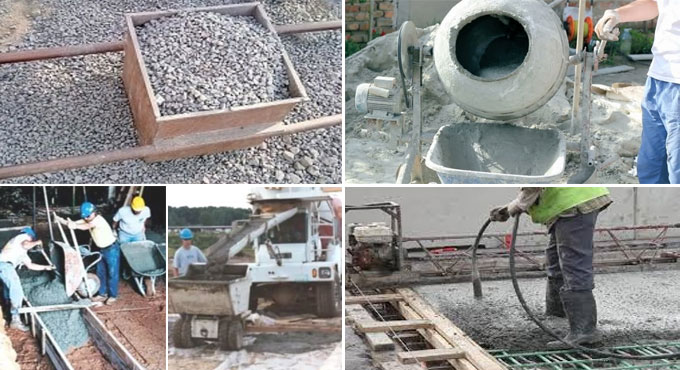NEWS | SOFTWARE | SHEET
Preparation and Placement of Concrete
The subsequent measures are included in the concreting: Batching, Mixing, Transporting, Placing and Compacting.
A) Batching: The assessment of materials for forming concrete is called batching. The subsequent two ways of batching are utilized:
1) Volume Batching: In this technique, sand, cement and concrete are grouped through volume. A gauge box is composed of wooden plates, its quantity as up to that of one cement bag. One cement bag has capacity of 35 litres.
The requisite quantity of coarse aggregate and sand is included through evaluating up on the gauge box. The amount of water needed for forming concrete is determined subsequent to determining water cement ratio. For instance, in case water cement ratio is 0.5 for one cement bag (50 kg), water needed is 0.5 x 50 = 25 kg, that is up to 25 litres. Appropriate portion is utilized to choose essential water quantity.
2) Weight Batching: That is the suggested batching technique. A weighing stand is utilized in the area to get right part of coarse and sand aggregates. Huge weigh batching plants possess mechanical weighing equipments.
B) Mixing: To make high-quality and consistent concrete, it is essential to blend coarse, sand and cement aggregate, initially in dry state and subsequently in wet state subsequent to including water.
The subsequent techniques are applied:
1) Hand Mixing: Essential quantity of coarse aggregate intended for a batch is measured and is dispersed on an impermeable stand. Subsequently, the sand needed for the batch is dispersed above coarse aggregate. They’re blended in dry state through restructuring the blend with spades.
Subsequently, the cement needed for the batch is dispersed across the dry mix and blended by shovels. Once homogeneous consistency is detected, water is included steadily and blending is resumed.
2) Machine Mixing: In huge and vital tasks, machine mixing is favoured. Essential amount of coarse and sand aggregates are put in the mixer drum. Four to five rotations are done for dry mixing and after that essential cement quantity is included and dry mixing is done with additional four to five rotations.
C) Transportation and placement of concrete: Subsequent to mixing, concrete must be transferred to the terminal point. In little works it is transferred in iron pans from one hand to the other of a group of workers.
Hand carts and wheel barrow could be utilized as well. On a grand scale pipes with pumps or belt conveyors and concreting chutes are utilized.
D) Concrete Compaction: In the method of laying concrete, air is restrained. The restrained air lessens the concrete strength up to thirty percent. Therefore, it is essential to take off the restrained air.
1) Hand Compaction: In this technique concrete is compressed through hurtling, compressing, scooping or through slicing by tools. In complex segments, a marked steel rod around one meter in length and of 16 mm diameter is utilized for ramming the concrete.
2) Compaction through Vibrators: It is possible to compress the concrete through utilizing high frequency vibrators.
To get more detail, go through the following video link civilsnapshot.com


